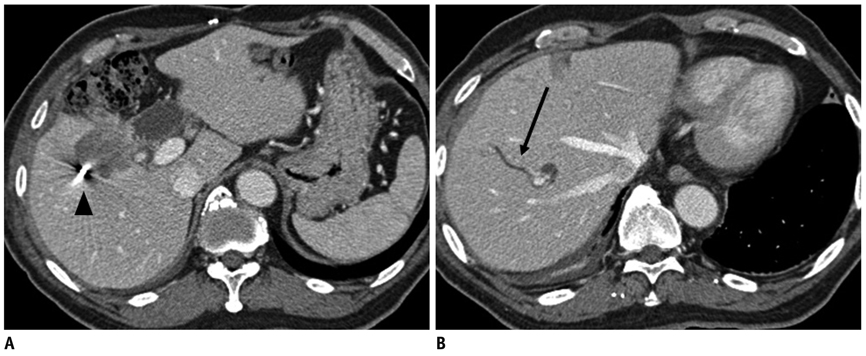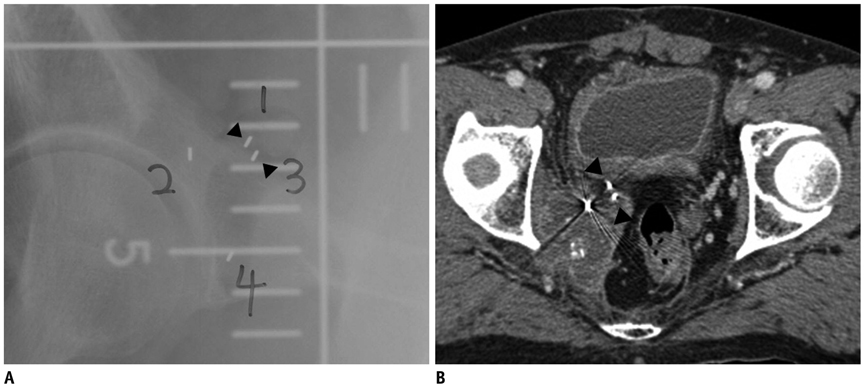Korean J Radiol.
2012 Jun;13(3):307-313. 10.3348/kjr.2012.13.3.307.
Safety and Efficacy of Ultrasound-Guided Fiducial Marker Implantation for CyberKnife Radiation Therapy
- Affiliations
-
- 1Department of Radiology, Soonchunhyang University Seoul Hospital, Seoul 140-743, Korea. hongses@schmc.ac.kr
- 2Department of Radiation Oncology, Soonchunhyang University Seoul Hospital, Seoul 140-743, Korea.
- 3Department of Neurology, Hallym University College of Medicine, Chuncheon 200-702, Korea.
- KMID: 1372850
- DOI: http://doi.org/10.3348/kjr.2012.13.3.307
Abstract
OBJECTIVE
To evaluate the safety and technical success rate of an ultrasound-guided fiducial marker implantation in preparation for CyberKnife radiation therapy.
MATERIALS AND METHODS
We retrospectively reviewed 270 percutaneous ultrasound-guided fiducial marker implantations in 77 patients, which were performed from June 2008 through March 2011. Of 270 implantations, 104 were implanted in metastatic lymph nodes, 96 were in the liver, 39 were in the pancreas, and 31 were in the prostate. During and after the implantation, major and minor procedure-related complications were documented. We defined technical success as the implantation enabling adequate treatment planning and CT simulation.
RESULTS
The major and minor complication rates were 1% and 21%, respectively. One patient who had an implantation in the liver suffered severe abdominal pain, biloma, and pleural effusion, which were considered as major complication. Abdominal pain was the most common complication in 11 patients (14%). Among nine patients who had markers inserted in the prostate, one had transient hematuria for less than 24 hours, and the other experienced transient voiding difficulty. Of the 270 implantations, 261 were successful (97%). The reasons for unsuccessful implantations included migration of fiducial markers (five implantations, 2%) and failure to discriminate the fiducial markers (three implantations, 1%). Among the unsuccessful implantation cases, six patients required additional procedures (8%).
CONCLUSION
The symptomatic complications following ultrasound-guided percutaneous implantation of fiducial markers are relatively low. However, careful consideration of the relatively higher rate of migration and discrimination failure is needed when performing ultrasound-guided percutaneous implantations of fiducial markers.
Keyword
MeSH Terms
Figure
Cited by 1 articles
-
Assessment of real-time US-CT/MR-guided percutaneous gold fiducial marker implementation in malignant hepatic tumors for stereotactic body radiation therapy
Sungjun Hwang, Seok-Joo Chun, Eui Kyu Chie, Jeong Min Lee
J Liver Cancer. 2024;24(2):263-273. doi: 10.17998/jlc.2024.06.03.
Reference
-
1. Chang SD, Main W, Martin DP, Gibbs IC, Heilbrun MP. An analysis of the accuracy of the CyberKnife: a robotic frameless stereotactic radiosurgical system. Neurosurgery. 2003. 52:140–146. discussion 146-147.2. Sotiropoulou E, Stathochristopoulou I, Stathopoulos K, Verigos K, Salvaras N, Thanos L. CT-guided fiducial placement for cyberknife stereotactic radiosurgery: an initial experience. Cardiovasc Intervent Radiol. 2010. 33:586–589.3. Kothary N, Heit JJ, Louie JD, Kuo WT, Loo BW Jr, Koong A, et al. Safety and efficacy of percutaneous fiducial marker implantation for image-guided radiation therapy. J Vasc Interv Radiol. 2009. 20:235–239.4. Leskell L. Stereotaxis and Radiosurgery: an operative system. 1971. Springfield, IL: Charles C. Thomas;5–51.5. Lax I, Blomgren H, Larson D, Näslund I. Extracranial stereotactic radiosurgery of localized targets. J Radiosurg. 1998. 1:135–148.6. Chang SD, Murphy MI, Martin DP, Hancock SL, Doty JR, Adler JR. Image-guided robotic radiosurgery: clinical and radiographic results with the CyberKnife. Radiosurgery. 1999. 3:23–33.7. Shirato H, Harada T, Harabayashi T, Hida K, Endo H, Kitamura K, et al. Feasibility of insertion/implantation of 2.0-mm-diameter gold internal fiducial markers for precise setup and real-time tumor tracking in radiotherapy. Int J Radiat Oncol Biol Phys. 2003. 56:240–247.8. Adler JR Jr, Murphy MJ, Chang SD, Hancock SL. Image-guided robotic radiosurgery. Neurosurgery. 1999. 44:1299–1306. discussion 1306-1307.9. Chang SD, Adler JR. Robotics and radiosurgery--the cyberknife. Stereotact Funct Neurosurg. 2001. 76:204–208.10. Ryu SI, Chang SD, Kim DH, Murphy MJ, Le QT, Martin DP, et al. Image-guided hypo-fractionated stereotactic radiosurgery to spinal lesions. Neurosurgery. 2001. 49:838–846.11. Berbeco RI, Nishioka S, Shirato H, Chen GT, Jiang SB. Residual motion of lung tumours in gated radiotherapy with external respiratory surrogates. Phys Med Biol. 2005. 50:3655–3667.12. Kothary N, Dieterich S, Louie JD, Chang DT, Hofmann LV, Sze DY. Percutaneous implantation of fiducial markers for imaging-guided radiation therapy. AJR Am J Roentgenol. 2009. 192:1090–1096.13. Cardella JF, Bakal CW, Bertino RE, Burke DR, Drooz A, Haskal Z, et al. Quality improvement guidelines for image-guided percutaneous biopsy in adults. J Vasc Interv Radiol. 2003. 14:S227–S230.
- Full Text Links
- Actions
-
Cited
- CITED
-
- Close
- Share
- Similar articles
-
- Endoscopic Ultrasound–Guided Fiducial Placement for Stereotactic Body Radiation Therapy in Pancreatic Malignancy
- Intravascular Placement of Metallic Coils as Lung Tumor Markers for CyberKnife Stereotactic Radiation Therapy
- Verification of X-sight Lung Tracking System in the CyberKnife
- Assessment of real-time US-CT/MR-guided percutaneous gold fiducial marker implementation in malignant hepatic tumors for stereotactic body radiation therapy
- Prospective evaluation of fiducial marker placement quality and toxicity in liver CyberKnife stereotactic body radiotherapy




